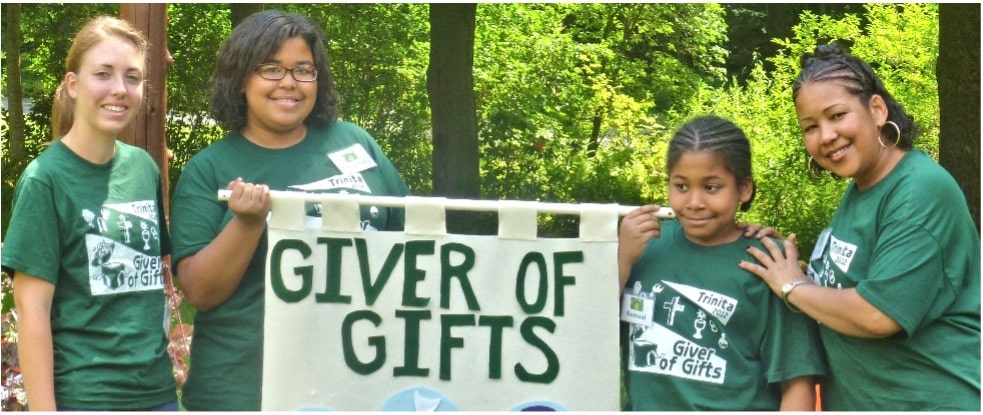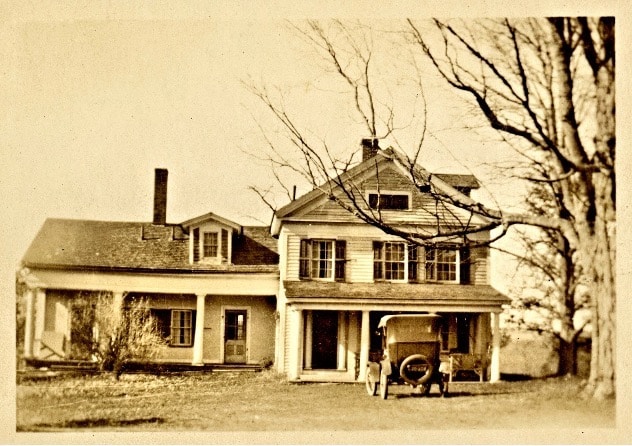
The Story of Trinita’s First 100 Years
1923 to 1931
On June 20, Mr. Patrick Menahan signed over the deed to his family summer home property to the Missionary Servants of the Most Blessed Trinity (MSBT). On July 20, Bishop Nilan gave Father Judge permission for the Sisters to open a mission on the property. Everyone called it “Town Hill” back then.
The first MSBT arrived on July 2, 1923: Sisters Mary James, Mary of the Precious Blood, and Margaret Mary. The place was a mess. The old farmhouse was overgrown, windows were broken. Also, it had not kept up with the times. There was no electricity or running water. The sisters got to work cleaning and recruiting help.
Two weeks later, on July 22, Blessed Trinity Missionary Cenacle was officially opened. Father Judge celebrated the first mass on that day. The mass was offered for the soul of Mr. Menahan, who had died soon after he donated the land to the sisters.
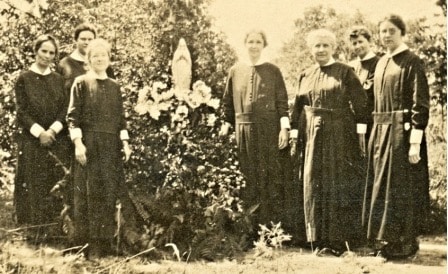
Sr. Thomas Marie Higgins was appointed as the first Custodian (local Superior). Other sisters were sent to the mission. With the help of Mr. Joseph Boyle, a tenant farmer, the land was farmed. The sisters helped with farming and the care of the chickens. They did canning and gardening. This helped keep expenses down.
The sisters’ mission was to strengthen Catholic faith in any way they could. They gave first communion classes and religious education for children who lived walking distance to the mission, which was closer for them than Immaculate Conception. The sisters also began retreat ministry. They provided hospitality to priests, sisters, and lay women who were on vacation or recovering from illness.
The MSBT managed to borrow money and get donations to start building up the property. They added a wing on the farmhouse. This was for the chapel. The rooms above it became guest rooms for people on retreat. On September 6, 1926, the new Chapel was dedicated by Rt. Rev. Maurice McAuliffe, who was Auxiliary Bishop of Hartford at the time.

Sr. Mary Anna Turner became the next Custodian in 1928, until 1931. She oversaw continued improvements, such as electric lights. The sisters advertised the retreat house and had a steady stream of local retreatants. The Little Flower Club from St. Patrick Parish in Collinsville came to Town Hill for monthly gatherings. Many priests and sisters visited for rest and retreat.
The ministry at Town Hill was thriving. However, the property was a challenge to maintain. In 1926 the sisters were snowed in for three weeks. In 1930 there was a drought and they had to haul water in barrels from Valley Spring. They had mounting bills. The cenacle was closed in 1931 and the sisters were sent to other missions.
1935 to 1969
Camp Trinita was born in the summer of 1935. Every spring and summer until 1957, Trinita was used for weekend retreats and for a summer camp for girls. The sisters did not live at Trinita year-round, but would come from other missions to help with the work.
Sr. Mary James oversaw the first camp in 1935. Girls came from surrounding towns, and sisters came to clean, cook, and staff the retreats and camp. They stayed in the main house and two small cottages. They used the barn for activities. There was a small pond past the barn which became known as “Our Lady’s Pool.”
A new pool, built on the site of the original pond, was finished on June 8, 1945. The barn had many renovations over the years. It was called St. Joseph Hall. It was furnished with rockers, chairs, small tables, many bookshelves, and a piano. Over time, St. Joseph Hall had a shower room, a laundry room, an infirmary, and a stage added. Giant “dormers” were put in to raise the roof, and a ceiling was put in to create a huge attic. A fireplace was added. You can see how the original barn is captured inside our Lodge.

The summer camp itself was probably typical of its time. A lifeguard was hired who gave swimming lessons and supervised the pool. Sisters took care of everything else: meals, laundry, arts and crafts, games, prayers, cleaning, and so on. The number of campers fluctuated from about 30 to 60 in the course of the summer. Trinita was also well used for retreats both before and after the annual summer girls camp.
Camp Trinita was used as a kind of “fresh air program” by the many MSBT who worked in foster care at Catholic Charities in Philadelphia. Thus, campers were a blend of local girls and inner city girls of many nationalities. However, it does not appear to have been racially diverse.
The last girls camp was 1957. Because the sisters who did the work were now required to take summer college classes, they couldn’t staff the camp. The mission continued to be used for weekend retreats in the summer months throughout the 1960s. Mostly it was used for MCA retreats and also by groups from the Southington mission, St. Thomas Parish. (The MCA is the lay organization that the MSBT are connected to.) People who wanted to use Trinita had to clean it themselves. Even so, there were many spring and summer retreats.
From 1965 to 1969, the Sisters of the Good Shepherd based in Hartford used the facilities to run their own summer program for troubled teen girls. MSBT leaders were waiting for inspiration about what to do with Trinita next.
1970 to 1984
On October 8, 1970, Reverend Ted Barlow, pastor of Pleasant Valley United Methodist Church, wrote a letter to the MSBT leaders to see if they could work together to use the property for youth ministry. On July1, 1972, a contract with Ted Barlow and MSBT was signed. Ted and his wife Karin and their children moved in and began work to restore the grounds and buildings. Soon, local churches of all denominations began to send youth groups for weekends. Ted began researching ways to collaborate with nearby non-profits working with elderly, prisoners, the poor, and others.
The Barlows oversaw a number of major improvements in their 14 years. They had to remedy broken windows, untended grounds, inadequate water drainage, leaking roofs, and so on. The basement living space was renovated and expanded into a small 3-bedroom apartment in 1978. Electrical wiring was brought up to code, and much original plumbing was replaced in 1981.
In the Fall of 1972, the MSBT and Catholic Charities in New York collaborated with the Barlows to give a retreat for troubled teens. This gave them the idea of a program for inner-city families. MSBT invested $20,000 in capital improvements and repairs for virtually every building on the property to prepare for the first Family Life Development Program.
The Family Life program was launched in the summer of 1973. The families did much of the work needed to run the program. A few sisters and volunteers ran the activities. Over the following summers, volunteer recruitment expanded and more MSBT offered to help. Karin Barlow did most of the cooking, and Ted handled maintenance and groundskeeping. Always, families had to pitch in to help. Eventually, Missionary Cenacle Volunteers was established to recruit, screen and provide formation for volunteers from all over the US who came to serve.
The summer program evolved over time. For the first few summers, the same materials and themes were re-used. The first fully developed summer theme was in 1983: “Happiness is Coloring Your Life.” T-shirts were silkscreened with a rainbow logo. Program content emphasized family communication, God’s love, and outreach to others. The summer Family Life Development Program still follows this format and these essential messages.
Sr. Margaret Fay oversaw the summer program until 1988. Lay volunteers and MSBT assisted her in leadership roles, along with a steady supply of Missionary Cenacle Volunteers. Father Vincent Fitzpatrick ST first served as chaplain in 1982, and returned every summer until 2005. In addition to his role as chaplain, he silk-screened all the summer t-shirts and did many repairs.
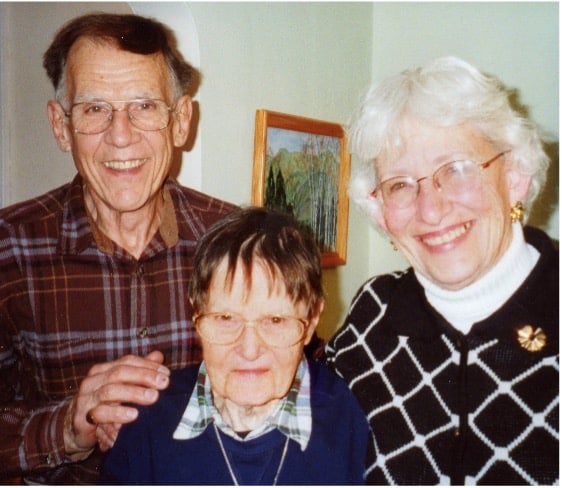
Ted and Karin and their children all continued to improve the property in all aspects during their years at Trinita. MSBT provided funds, but the Barlows did as much of the work themselves as they could, and recruited volunteer labor whenever possible.
There is absolutely no question that but for the Barlow Family, the mission of Trinita would not have survived. The Sisters did not have the funds or the personnel to invest in the mission at that point in time. There were times when the logical choice would have been to sell the property. But Ted Barlow’s vision and energy were infectious and kept the mission alive.
1984 to 1992
Bill and Anita Panagakos and their infant daughter Leah succeeded the Barlow family in 1984. Like the Barlows, they were responsible for maintaining the property and hosting weekend groups. MSBT funding was limited, and they were encouraged to find economical solutions and develop volunteer support. Bill worked as a teacher and Anita was employed by MSBT. They further developed Trinita as a place where teens could feel at home. Many retreat centers in the area were not open to hosting teenagers. As they raised their growing family, they modelled healthy family life to the teen groups and to the families who came for the summer program.
The Barlows had done amazing work, but Ted nevertheless had to pass on to Bill a daunting list of maintenance concerns. The Chalet, a cabin used for male summer volunteers, was slowly rotting away. The basement apartment (cenacle) often flooded after heavy rain. During the summer, water shortages were routine. Many of the roofs needed work. However, MSBT finances were very limited. Bill was able to organize some skilled volunteer labor for some projects, but mostly things had to be put on hold. Thanks to a special fund-raising project, the cabin bathrooms were renovated in 1991 and showers were installed.
To compensate for limited funding, Bill and Anita began hosting a work weekend every May, which continued as a tradition for many years. Sisters from nearby missions would bring parish volunteers for a fun weekend of painting, cleaning, and groundskeeping.
Over time, Anita was able to expand Trinita’s clientele, and almost every weekend was booked. Trinita became known as a great place for parish confirmation retreats. Archbishop Whealon developed a friendship with the Panagakos family. Also, regional AA groups discovered a home at Trinita and had regular weekend retreats there.

By 1992, the Panagakos family had grown from three to five. They made the decision to move in 1992. Like the Barlow Family, the Panagakos Family brought new life to the mission. They built new relationships with local Catholics and local parishes that have continued to this day.
1992 to 2018
In September of 1993, three MSBT moved in and established Trinita Missionary Cenacle: Sisters Ann Miriam Gallagher, Margaret Burnard, and Joan Louise Packer. In the ensuing years, various sisters moved in and out, so that there were up to four sisters in residence until 2018. 
As funding became available, MSBT began major improvements which had been long deferred. Benefactors were responsible for several major renovations. In August of 1998, St Luke Parish in the Diocese of Bridgeport sponsored a complex renovation project which included donated skilled labor and the donation of major restaurant kitchen appliances. In a single weekend, skilled volunteers gutted and completely renovated the retreat center kitchen. They also built a large storage shed and pavilion. The kitchen was transformed into a modern facility which could pass inspection by the Board of Health.
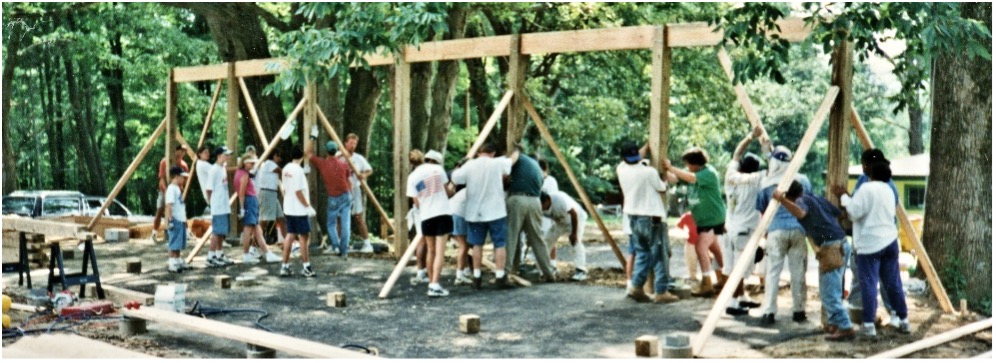
In 2002, Joseph and Florence Colette donated money and labor to build a Grotto at Trinita in memory of their daughter Kimberly Jo Colette. The Grotto was dedicated to her and to other young victims of illness and tragedy.
In 2006 the Buda and Moran families collectively donated $20,000 and provided skilled volunteer labor to renovate the Lodge interior, in memory of Linda Moran’s mother. The old Snack Koop was torn down and replaced, the stage area was insulated, heaters were installed, old shelving was pulled out, and the collection of old battered chairs and couches were removed and replaced with new upholstered stackable chairs. The families celebrated a memorial mass in the Lodge for Janice Moran on June 17, 2006.

The Sisters continued hosting retreat groups. But they also were able to offer their own retreats. They began to do outreach and off-site retreats. To expand their outreach, they began an active campaign of volunteer recruitment. Local parishioners and friends made pancake breakfasts, helped with cooking, serving and dishwashing, gardening, and many other tasks. Soon, volunteers were recruited for program work as well: facilitation, lesson planning, arts and crafts, fund raising events. The sisters developed relationships with local vendors and were often able to get in-kind donations of food and supplies.


The Summer Family Life Development Program continued uninterrupted and largely unchanged over all these years. Originally, Missionary Cenacle Volunteers from all over the US were the labor force for all aspects of the summer program, but the Sisters developed a component for local volunteers. Members of the MOMs group became an especially critical support. Also, the local MCA members supported much of the ministry.
The year round programs created the need for more staff. For many years, Trinita’s team included the sisters in residence, plus Patricia Kenyon, Ellen Arnold, Diane Gumbert, and Vinny Maliczewski. Lay staff became more and more an integral part of both planning and execution of programs. Like the sisters, there were many staff changes over time.
2018 to 2023
As of June 2018, there were no longer MSBT in permanent residence at Trinita. Many MSBT continue to visit regularly. Ellen Arnold came in 2005 and became Associate Director in 2012. Vincent Maliczewski began as a maintenance worker in 2008 and is now Facilities Manager. Steve DiMotta, who was hired in 2014 as Program Coordinator and then as Associate Director, became Director in 2019. The staff now also includes Laurie Janecko (program coordinator), Jen Moros (cook) and Henry Patnode (groundskeeper).
The new Mission Cross was erected in 2018 to replace the original cross which had been raised in 1986. The Low Ropes Course was completed in 2018 and St. Peter/St. Francis School in Torrington became the first group to use the new course. In 2019, Tim Traub and friends were able to donate and install an elaborate used playground structure to replace the two aging playscapes in the playground area.
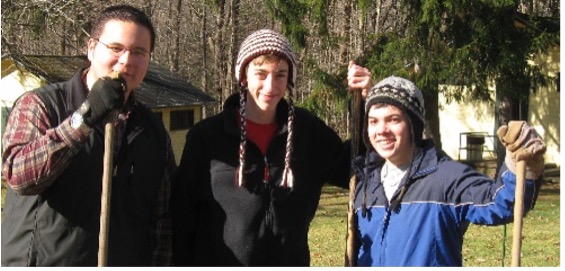
Throughout its history, Trinita has relied on volunteer work to keep expenses down. Donations and the generosity of benefactors have been needed to help Trinita remain an affordable option for area parishes and other groups. Many local parish youth groups have come for work days, notably Immaculate Conception Parish, St. Mary Magdalen in Watertown, and St. George in Guilford. The Sisters Dinner Club was established in 2013 and took on a variety of creative fund-raising projects over the years: Meals-to-Go, the Christmas Fair, Tag sales, the Craft Fair, Bingo Night, Beef and Beer, International Night, Oktoberfest, and Thanksgiving pie sales.
With the pandemic, Trinita closed to on-site programs in March 2020. Steve and Ellen adapted by developing on-line programs. Vinny and Rachel Farr (cook) did major cleaning projects. The Girls Night Out group continued via monthly Zoom sessions. Steve developed methods for doing on-line youth ministry and gave training seminars for youth leaders. The Team sponsored a regular Friday rosary with social distancing on the front lawn.
The Trinita Team was very reluctant to cancel the annual summer Family Life Development Program, which had continued uninterrupted since 1973. As an alternative, they developed a “Trinita@Home” approach, live streaming to Trinita families, friends and volunteers. This approach was used for the summers of 2020 and 2021. There were even themed T-shirts printed. Thus, the program continued uninterrupted at least in spirit. As the pandemic has eased, some things have come back to normal and some have not. Much is being restored or renewed in the centennial year of 2023. Old friends are returning.
Trinita is holy ground.
It has been made holy by the people who have walked on it, worked on it, and loved it for these past one hundred years. Its future is unknown, but its needs remain the same. For Trinita to have a viable future it needs what it has always needed: friends who will come to encounter God and one another; donors and benefactors who will invest in building a healthy and functional facility; volunteers who give witness to God’s Kingdom by their service in so many ways; a team of staff, MSBT, and volunteers who can discern, plan and carry out Trinita’s mission for the next one hundred years.
Do you see yourself in Trinita’s future?
